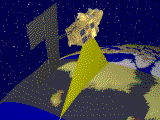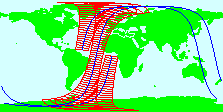Thanks to its ground swath of 2250 km, the Vegetation instrument can cover almost
all land masses in the 14 orbital revolutions completed each day. Several areas near
to the equator not covered one day will be covered the next day. Above a latitude of 35°,
all areas are imaged at least once a day.
The corresponding data are stored onboard in a mass memory and retransmitted to the
ground when the Kiruna station
is visible.
Vegetation includes 2 independent transmission channels which can simultaneously
transmit:
- direct imaging data with a resolution of around 1 km transmitted in the L-band so that
the regional stations visible by the satellite can receive Vegetation data (regional mode),
- recorded data with a resolution of around 1 km transmitted in deferred mode on a
"recorded channel" (global mode) to the Kiruna X-band
station.
The result is systematic programming called routine programming. The main
characteristics of a routine programming are as follows:
- a latitude range per orbit: typically 58° S, 70° N for all orbits,
- a maximum solar zenith angle
Within this area, the image acquisition logic is as follows:
- direct transmission and simultaneous recording in memory of images acquired over land
masses,
- direct transmission only of images acquired over the oceans.
To determine recording limit, we calculate the Land / Sea Ratio over imaging segments
of 10 seconds (around 70 km on the ground). This LSR is compared with an
adaptable threshold allowing fine control of the recording ranges; we can, for example,
alter this threshold to optimize recording of high latitude overlap areas.
top of page, article, section
The Vegetation Programming Center
(CPV) also manages exceptional programmings intended to meet technological requirements
(equipment tests, calibrations and specific imagings for image quality monitoring) and
specific programmings over a given geographical area defined by a quadrilateral or a
circle; the solar illumination threshold, the LSR and required imaging mode are also
specified.
These programmings are managed with a processing priority over the routine programming.
This priority is required to obtain optimum management of the mass memory recording
capacity. If the memory is insufficient to record the complete programming, the CPV is
capable of automatically taking the following measures:
- increasing dump capacity by adding a Kiruna pass
not retained in the initial work plan,
- application of a reduction algorithm for the data to be recorded taking priority,
illumination, LSR and data latitude criteria into account.

This animated illustration shows the swath covered by the
Vegetation instrument. The scenes are acquired during the day over exposed land and
viewing stops when the satellite crosses the oceans. In this example, the viewing begins
over Greenland, then starts again over Newfoundland before covering South America.
top of page, article, section
The CPV offers the following functions:
- constant review and management of all mission-specific programming needs (global
coverage, regions of special interest,...), payload-specific programming needs
(calibration...) and system constraints (memory capacity, equipment operating times,
satellites manoeuvres,..),
- generation of payload programming on the basis of these needs and constraints,
- formatting of programming instructions as SPOT 4 telecommands,
- monitoring of vegetation workload and generation of statistics on operating time logged
by various items of payload equipment,
- monitoring of the entire « image loop », which is to say, comparison of programming
with the imagery actually acquired then processed by the Vegetation image
processing center (CTIV) to ensure quick response in the event of an anomaly,
- scheduling of Kiruna SRIV
activities to accommodate memory dumps sessions,
- archiving of all data relating to Vegetation programming.
It operates according to the two following operational modes:
- OPERATION mode to elaborate programming from acknowledgment of requests through
generation of programming message to be transferred to satellite. This mode operates
daily.
- STUDY mode allowing the CPV operator to make a preliminary feasibility study of the
programming and optimize the programming parameters to available resources (memory
capacity, Kiruna station availabilities, etc.). This mode produces no programming
messages.
Programming study is prepared with the STUDY mode and validated by the Vegetation system
operator. The Vegetation payload is programmed once each day after the predicted orbite
for the next day has been computed. Programming instructions are transmitted to the Satellite Control Center (CCS) to be uplinked
to the satellite at the same time as those for SPOT 4’s main payload during
evening passes over Aussaguel station from CNES
2 Ghz network.
top of page, article, section

page updated on the 00-06-06


![]()